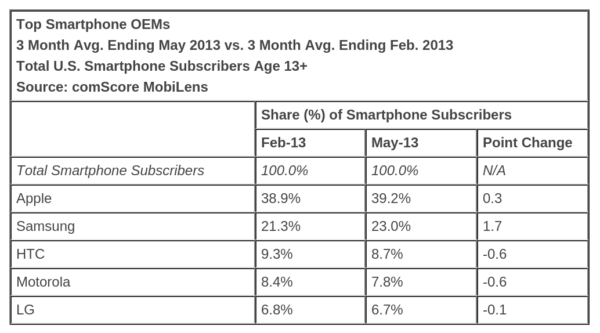Mobile Market Share: Android, iPhone Gain While Others Flail
On Friday comScore released its US smartphone market share report for May. The firm projects that 59 percent of US mobile phone subscribers own smartphones. By comparison Pew and Nielsen both agree that the number is 61 percent. According to comScore Apple continued to be the top individual smartphone maker in the US, followed by […]

According to comScore Apple continued to be the top individual smartphone maker in the US, followed by Samsung. Android gained some share as the top platform, followed by the iPhone. Taiwan-based HTC, Google-owned Motorola and LG all saw declines.
Motorola really needs a hit with the forthcoming Moto X phone. It’s not clear, however, the at company will be able to deliver one. While past Motorola Android handsets have stood out with their long battery lives they’ve otherwise been undistinguished from the rest of the Android pack, with largely uninspired, even awkward designs.
Moto X will be made in the US, which will be part of its marketing undoubtedly. That may cause some number of people in the US to buy it or consider it more seriously. But Motorola needs to deliver an elegant, powerful phone or it’s going to continue to see loses.
BlackBerry released quarterly results on Friday and they weren’t good. The company was expected to post a profit but instead reported an $84 million loss. The Canadian company said it had shipped 6.8 million smartphones. However of those only 2.7 million were BlackBerry 10 handsets (Z10 and Q10).
This argues that the market is largely ignoring its new flagship devices.
The same can probably be said for Windows Phones. Microsoft has seen some isolated share gains in Europe. There was also a suggestion at one point that Windows Phones were gaining share in the US. But any US momentum the platform may have had appears to have stalled.
As a further illustration of the “facts on the ground,” the following are StatCounter data showing actual US web traffic driven by the competing mobile operating systems:
- iOS: 54 percent
- Android: 40 percent
- BlackBerry: 2.2 percent
- Windows Phone: 1.2 percent
- Other: 2.6 percent
Contributing authors are invited to create content for MarTech and are chosen for their expertise and contribution to the martech community. Our contributors work under the oversight of the editorial staff and contributions are checked for quality and relevance to our readers. The opinions they express are their own.
Related stories

